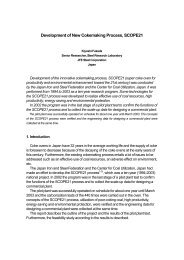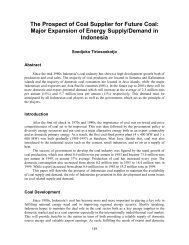Defining CCS Ready: An Approach to An International Definition
Defining CCS Ready: An Approach to An International Definition
Defining CCS Ready: An Approach to An International Definition
- No tags were found...
Create successful ePaper yourself
Turn your PDF publications into a flip-book with our unique Google optimized e-Paper software.
3.3.2 Environmental, Safety, and Other ApprovalsChapter 3: Transport <strong>Ready</strong> Plant <strong>Definition</strong>With the range of potential approvals and permits required <strong>to</strong> construct and operatepipelines, <strong>CCS</strong> <strong>Ready</strong> requirements include evaluating future approvals. Considerationshould be given <strong>to</strong> both international and national laws and standards. Addressing theseapprovals as part of <strong>CCS</strong> <strong>Ready</strong> will help <strong>to</strong> ensure that transport sites will be able obtain allneeded approvals, as well as allocate enough time for the permitting processes.The issue of CO 2 pipeline safety, and the associated approvals, will become increasinglyimportant as <strong>CCS</strong> <strong>Ready</strong> regulations and guidelines are developed that will govern thedesign of these networks. Pipelines in proximity <strong>to</strong> populated areas will likely be subject <strong>to</strong>increased scrutiny. The IPCC compared the failure incidence rates for CO 2 pipelines with oiland gas pipelines and found the rates <strong>to</strong> be similar (see Exhibit 3-3). The causes for CO 2pipeline incidents include equipment failure, corrosion, and outside force. 70 The IPCC foundthat the risks associated with CO 2 pipelines are similar <strong>to</strong> oil and natural gas pipeline risks,and these risks are well unders<strong>to</strong>od and can be successfully managed. 71Exhibit 3-3: Failure Incidence Rates for Oil and Gas PipelinesRegion/systemEuropean gas pipelines, 1972-2002(European Gas Pipeline Incident DataGroup, 2002)Western European oil pipelines, 1997-2002 (CONCAWE, 2002)US onshore gas pipelines, 1986-2002(CONCAWE, 2002)US CO2 pipelines, 1990-2002 (Galeand Davidson, 2002)Failure Frequency(failures per year per km)0.0002(all pipelines)0.00005(>0.5 m diameter)CommentsAll unintentional releases for gas pipelinesystems over 1.5 MPa0.0003 All incidents that resulted in injury, death orproperty loss >US$ 50,0000.00011 All incidents that resulted in injury, death orproperty loss >US$ 50,0000.00032 10 incidences, no injuries or death, <strong>to</strong>talproperty damage US$ 469,000Source: IPCC, compiled from sources in parentheses.The IPCC, the US Department of Transportation, and NETL have noted that the integrity ofthe pipeline can be compromised due <strong>to</strong> the presence of contaminants in the CO 2 pipeline,such as water, H 2 S, methane, and oxygen. Water can react with CO 2 or H 2 S <strong>to</strong> formcarbonic or sulphuric acid, respectively, both of which can corrode and fracture a pipeline.Under certain conditions, hydrates (solid ice-like crystals) can form and plug the pipeline.The presence of oxygen can result in the formation of bacterial colonies, which can interferewith injection.Leaking pipelines can present dangers <strong>to</strong> human health and safety. CO 2 is an asphyxiant andcan be dangerous above levels of 5,000 ppm, 72 which could occur if leaking CO 2 accumulates70 World Resources Institute (WRI). (2008). <strong>CCS</strong> Guidelines: Guidelines for carbon dioxide capture, transport, and s<strong>to</strong>rage.Washing<strong>to</strong>n, DC: Author.71 Intergovernmental Panel on Climate Change (IPCC). (2005a). IPCC Special Report on Carbon Dioxide Capture andS<strong>to</strong>rage. New York, NY: Cambridge University Press.72 5,000 ppm is the maximum permissible exposure limit in the United States. See U.S. Department of Labor, OccupationalSafety & Health Administration (U.S. DOL-OSHA). (2007). Chemical sampling information: Carbon dioxide.23 February 2010 41
















